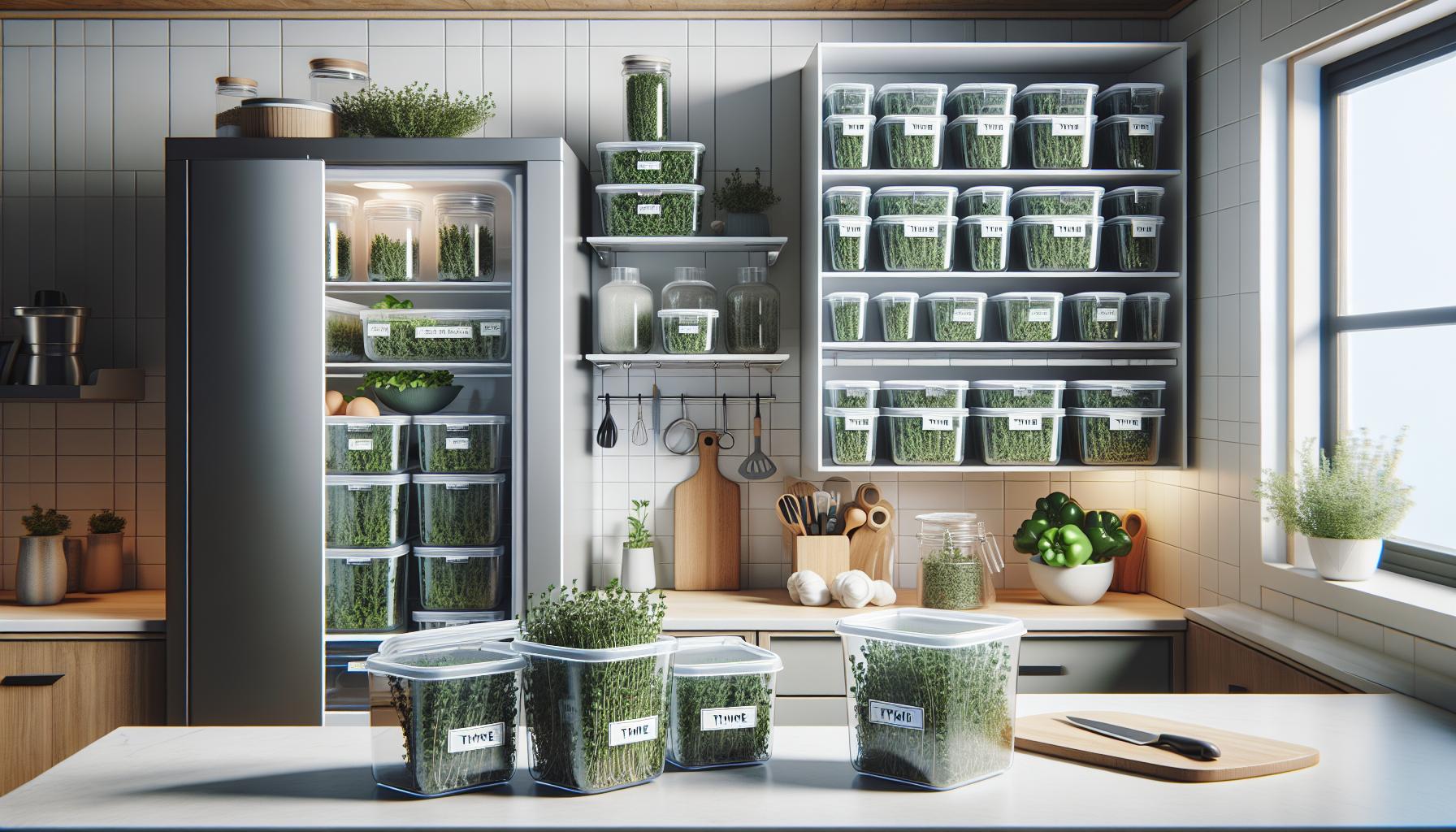Thyme is not just a delightful addition to your culinary creations; it’s also an herb that can quickly lose its freshness if not stored properly. Understanding how long thyme lasts in the fridge is crucial for maximizing its flavor and ensuring you get the most out of your herbs. With the right storage techniques, you can not only extend the shelf life of thyme but also enjoy the full benefits of its aromatic qualities in your dishes.
When you take the time to properly store thyme, you reduce waste and save money, keeping your meals vibrant and flavorful. Whether you’re an experienced cook or just starting your culinary journey, knowing how to keep this herb fresh can enhance your cooking experience and minimize trips to the grocery store. Read on to discover practical tips and guidelines for ensuring your thyme remains in peak condition and ready to elevate your meals any day of the week.
How Long Can Thyme Last in the Fridge?
Thyme, a beloved culinary herb, can retain its freshness for a limited duration when stored properly in the refrigerator. Typically, fresh thyme can last anywhere from one to two weeks in the fridge, depending on the conditions in which it’s stored. Factors such as moisture, air exposure, and overall freshness at the time of purchase play significant roles in its longevity. To ensure you’re getting the most out of your thyme, it’s essential to know how to store it effectively.
To maximize its shelf life, wrap fresh thyme in a slightly damp paper towel and place it inside a plastic bag or airtight container. This method helps maintain the necessary moisture without suffocating the herb, which can lead to spoilage. Alternatively, placing the thyme upright in a jar with a small amount of water, much like a bouquet of flowers, can also keep it fresh for a longer time, though this method requires that you change the water regularly.
When storing thyme, it’s crucial to regularly check for signs of spoilage. Look for browning leaves, a wilted appearance, or an off smell, which indicates that the thyme is no longer fresh. Discard any spoiled portions to help preserve the remaining good quality thyme, ensuring that your culinary endeavors continue to benefit from this aromatic herb.
Signs of Fresh vs. Spoiled Thyme
Fresh thyme is a versatile herb, but understanding its freshness is crucial for ensuring quality and flavor in your dishes. Recognizing the signs of fresh versus spoiled thyme can make a difference in your cooking and help you avoid using herbs that may compromise your meal.
Initially, fresh thyme should have vibrant green leaves that feel firm to the touch. The stems will appear sturdy, and the whole herb should emit a fragrant, earthy aroma. Fresh thyme can stimulate your senses and elevate your dishes with its aromatic profile. To confirm its freshness, consider the following indicators:
- Color: Fresh thyme leaves are a bright green. If the leaves have turned brown or yellow, they are likely past their prime.
- Texture: The leaves should be pliable yet crisp. If they feel limp or dry out, the herb may be starting to spoil.
- Aroma: A strong, pleasant scent indicates freshness. If the thyme smells musty or has lost its aroma, it’s a clear sign that it has aged.
On the contrary, spoiled thyme presents a range of characteristics that are important to note before use. Wilted or mushy leaves, excessive browning, or signs of mold clearly indicate spoilage. Moreover, thyme that emits an off or foul odor should be discarded. Consuming spoiled herbs can not only alter the taste of your dish but could also pose health risks if mold is present.
By knowing these key indicators, you can confidently evaluate the state of your thyme, ensuring that you enhance your culinary creations with the freshest ingredients.
Best Storage Techniques for Fresh Thyme
To keep fresh thyme flavorful and vibrant during storage, it is essential to apply the right techniques. Proper handling ensures that the herb can last up to two weeks in the fridge, delivering maximum taste to your culinary creations.
Start by preparing the thyme correctly. First, rinse the sprigs under cool water to remove any dirt or contaminants, then pat them dry gently with a paper towel. It’s crucial that the thyme is completely dry to prevent moisture from causing mold. Once dried, you can choose between a few popular storage methods:
Storage Methods
- Refrigerator in a Paper Towel: Wrap the thyme sprigs in a slightly damp paper towel, then place them inside a plastic bag. This method provides a balance of moisture while allowing airflow, keeping the thyme fresh.
- In a Jar of Water: Trim the stems at an angle and place them upright in a jar filled with water, much like a bouquet. Cover the leaves loosely with a plastic bag and store it in the fridge. This can help the thyme stay hydrated and retains its flavor longer.
- Seal in an Airtight Container: For longer-term storage, consider removing the leaves from the stems and placing them in an airtight container. Keep this in the fridge for around a week, ensuring the leaves are dry to avoid spoilage.
By using these techniques, you can significantly extend the shelf life of thyme, maintaining its aromatic qualities. It’s also advisable to check your stored thyme regularly and apply necessary adjustments-if you notice any signs of wilting or discoloration, it may be time to dispose of it to avoid compromising the integrity of your meals.
How to Extend the Shelf Life of Thyme
To ensure you keep your thyme as fresh as possible for extended periods, a combination of proper storage techniques and careful handling is essential. When stored correctly, thyme can last in the fridge for up to two weeks. However, by implementing a few simple strategies, you can further prolong its shelf life and maintain its vibrant flavor and aroma.
One effective method is to store thyme in a damp paper towel. Lightly mist a paper towel, wrap the thyme sprigs in it, and then place them inside a perforated plastic bag. This method provides just the right amount of moisture while still allowing for air circulation, which helps prevent mold and keeps the thyme from wilting. Alternatively, you can place trimmed thyme stems upright in a jar of water like a bouquet, covering them loosely with a plastic bag. This not only hydrates the herb but also allows it to retain its freshness longer.
For those looking for an even longer-term solution, consider freezing thyme. Simply wash and dry the sprigs, then spread them out on a baking sheet to freeze individually before transferring them to an airtight container. Frozen thyme can retain its quality for several months, making it a great option for later use in soups, stews, or marinades. If freezing is not an option, drying thyme is another way to extend its longevity-remove the leaves from the stems and store them in an airtight container in a cool, dark place.
Monitoring your stored thyme is crucial. Regularly inspect it for any signs of spoilage, such as discoloration or mushiness, and immediately remove any affected parts to preserve the integrity of the remaining herb. With these straightforward storage tips, you can enjoy the delightful taste and health benefits of fresh thyme for a longer time.
Freezing Thyme: Step-by-Step Guide
If you’re looking to preserve the vibrant flavor of thyme for extended periods, freezing is an excellent method that retains both its taste and nutritional benefits. Unlike drying, which can alter the herb’s flavor profile, freezing allows you to maintain thyme’s fresh aroma, making it ideal for culinary uses even months later. Here’s a simple step-by-step guide to effectively freeze thyme.
Start by selecting fresh, healthy thyme sprigs. Remove any stems that show signs of wilting or discoloration. Once you’ve assembled your thyme, wash the sprigs gently under cool water to remove any dirt or debris. Gently pat them dry with a paper towel or a clean kitchen cloth to prevent ice crystals from forming during freezing.
Next, prepare the thyme for freezing. You have a couple of options for this step:
- Individual Freezing: Lay the clean sprigs out in a single layer on a baking sheet lined with parchment paper. Place this sheet in the freezer for about one to two hours until the thyme is frozen solid. This method prevents the sprigs from clumping together.
- Chunk Storage: If you’re short on time, you can chop the thyme leaves and place them in ice cube trays. Fill each compartment with water or olive oil, then freeze. This method allows you to easily pop out portions for cooking.
Once your thyme is individually frozen or packed into ice cube trays, transfer the sprigs into an airtight freezer bag or container. Be sure to label the container with the date, and consider using a vacuum sealer for optimal preservation. Frozen thyme can maintain its quality for six months to a year, though it remains safe to consume beyond this period; its flavor may diminish over lengthy durations.
When you’re ready to use your frozen thyme, there’s no need to thaw it beforehand. Simply add the frozen sprigs or cubes directly to your cooking-perfect for stews, soups, and marinades. This practice not only saves time but also helps you make the most of your fresh thyme, ensuring you never let it go to waste.
Using Dried Thyme vs. Fresh Thyme
Using thyme, whether dried or fresh, significantly impacts the flavor and aroma of dishes. Fresh thyme brings a vibrant, intense flavor profile that enhances everything from soups to roasts, while dried thyme offers a more concentrated essence due to its reduced moisture content. Understanding the differences between these two forms can help home cooks make informed decisions about which to use in their culinary creations.
One of the most notable distinctions between fresh and dried thyme is the potency of flavor. Fresh thyme has a lively, aromatic quality that can elevate the taste of a dish, making it ideal for recipes where it’s added towards the end of cooking, allowing its oils and fragrances to infuse the food without losing their brightness. Conversely, dried thyme is more robust and holds up well in dishes cooked for longer periods, such as stews or marinades. It is typically recommended to use about one-third of the amount of dried thyme in place of fresh thyme because it is more concentrated. For example, if a recipe calls for one tablespoon of fresh thyme, you would use about one teaspoon of dried thyme.
Storage Considerations
Proper storage is crucial to maintain the quality of thyme, regardless of the form. Fresh thyme should be stored in the refrigerator wrapped in a damp paper towel inside a plastic bag, which can keep it fresh for about one to two weeks. Dried thyme, on the other hand, should be kept in an airtight container in a cool, dark place like a pantry, where it can last for several months. However, while dried thyme has a longer shelf life, its flavor diminishes over time, so it’s best to replace it every year to ensure potent flavor.
Cooking Tips
When it comes to cooking, the choice between fresh and dried thyme depends on the dish and desired flavor intensity. For instance, a fresh thyme sprig can simply be tossed into a pot at the end of cooking for a burst of flavor, while dried thyme is often added earlier, allowing its flavors to meld with other ingredients. Experimenting with both forms in various recipes can provide delightful insights into how they enhance culinary creations, allowing you to choose the best match for your taste preferences and cooking style.
Ultimately, knowing when to use fresh or dried thyme can enhance your cooking and elevate your dishes, ensuring you make the most of this versatile herb.
Thyme Storage Mistakes to Avoid
Storing thyme properly is essential for preserving its flavor and aroma, yet many people make common mistakes that can lead to spoilage and loss of quality. One significant error is improperly washing fresh thyme before storage. While it’s important to remove any dirt or debris, washing thyme and not drying it thoroughly can introduce excess moisture, leading to mold growth. Always ensure the thyme is patted dry before storage to extend its freshness.
Another mistake is neglecting to monitor the humidity levels where thyme is stored. For fresh thyme, a damp paper towel within a plastic bag in the refrigerator is ideal, but ensure the bag isn’t too tightly sealed; it needs some airflow. Conversely, dried thyme should be kept in a cool, dark environment like a pantry, but frequently opening the container can increase moisture exposure, diminishing its potency over time. A common approach is to keep dried herbs in an airtight glass jar, but avoid storing it above the stove where heat can compromise its quality.
Using plastic bags or containers that trap moisture instead of breathable materials can also shorten thyme’s lifespan. Favoring breathable options for fresh thyme will help it stay crisp, while ensuring dried thyme is stored in airtight containers keeps moisture out. Additionally, mixing fresh and dried herbs in the same container leads to cross-contamination, affecting the flavor integrity of both.
Finally, overlooking the expiration dates of dried thyme significantly impacts your cooking. It may look fine, but old dried thyme loses flavor. Set reminders to update your spice rack regularly, ideally every one to three years. By avoiding these pitfalls, you can keep your thyme fresh longer and enhance your culinary experiences.
Herb Preservation: Tips for Other Herbs
Storing and preserving herbs properly extends their lifespan and keeps their flavors vibrant. While thyme is a beloved favorite, understanding the needs of other herbs can enhance your culinary repertoire significantly. Each herb has unique storage requirements, but some general principles apply across the board for maintaining freshness.
Best Practices for Storing Fresh Herbs
For most fresh herbs, including basil, cilantro, and parsley, the method of storage can deeply influence their longevity. Here are some effective techniques:
- Water Storage: Just like flowers, many herbs thrive when their stems are placed in water. Trim the ends of the stems and place them in a jar with about an inch of water, covering the tops with a plastic bag. Store them in the refrigerator to keep them fresh for a week or longer.
- Brine Method: For herbs like rosemary or sage, a saline solution helps preserve freshness. Submerge the cleaned and trimmed herbs in a jar with a mixture of water and salt, sealing tightly.
- Paper Towel Wrap: Soft herbs such as dill and mint can be stored wrapped in a damp paper towel, placed inside a perforated plastic bag. This maintains humidity without trapping moisture that can cause decay.
Drying Herbs for Long-Term Storage
If fresh herbs are about to wilt or are in excess, drying is an excellent option. The key to effective drying is ensuring they are clean and dry before the process begins. Consider these methods:
- Air Drying: Bundling herbs and hanging them upside down in a dry, dark, and well-ventilated area prevents mold development.
- Oven Drying: For quicker results, use the oven on the lowest setting. Spread herbs in a single layer on a baking sheet and leave the oven door ajar, checking frequently to prevent burning.
- Dehydrator Use: A food dehydrator offers precise temperature control and faster drying times for herbs like oregano and thyme, maintaining their essential oils.
Recognizing Freshness
Monitoring the freshness of your herbs is equally important. Fresh herbs should be vibrant, fragrant, and free from brown spots or wilting. Spoilage indicators include slimy or darkened leaves, which signal that the herb has exceeded its freshness. Always discard herbs showing these signs to minimize health risks.
By mastering these storage tips, you can ensure your herbs remain flavorful and appealing for longer periods, elevating your culinary creations and reducing waste in your kitchen.
Health Benefits of Fresh Thyme
Fresh thyme is not just a culinary delight; it’s also a powerhouse of health benefits that can enhance your wellness. This aromatic herb is rich in vitamins and antioxidants, making it an excellent addition to your diet. Thyme is packed with vitamin C, which is essential for boosting the immune system and protecting the body against illness. Additionally, it contains vitamin A, which supports eye health and skin integrity.
Moreover, thyme is celebrated for its antimicrobial properties. These qualities can help fight off harmful bacteria and fungi, potentially aiding in the prevention of infections. The presence of thymol, a compound found in thyme, is particularly notable for its effectiveness in combating these pathogens. Incorporating thyme into your meals may not only amplify flavor but also contribute positively to overall health.
The benefits of thyme extend beyond nutrition. This herb has been traditionally used to alleviate respiratory conditions such as coughs and bronchitis. Its expectorant properties can help clear mucus from the airways, making it easier to breathe. Additionally, thyme’s soothing aroma can promote relaxation and stress relief, adding to its appeal as a kitchen staple that supports both health and culinary creativity.
Utilizing fresh thyme in various dishes not only enhances flavor but ensures that you can reap these health benefits. Remember, fresh thyme can last in the fridge for about a week, so using it regularly can help maximize its nutritional value. Explore creative ways to incorporate thyme into your cooking-whether it’s in marinades, soups, or roasted vegetables-and enjoy both the taste and health advantages it brings.
Creative Ways to Use Thyme Before It Expires
Utilizing fresh thyme before it expires not only preserves its flavor and health benefits but can elevate your culinary creations in delightful ways. This versatile herb can be incorporated into a variety of dishes, ensuring you enjoy its aromatic qualities while reducing waste. Here are some innovative ideas for making the most of your thyme.
Flavorful Herb-Infused Oils and Butters
A simple yet effective way to use fresh thyme is to create herb-infused oils or butters. Combine chopped thyme with olive oil or softened butter, then blend thoroughly. Use the oil for drizzling over vegetables or salads, while the butter can enhance grilled meats or spread on bread. These infusions not only capture thyme’s essence but also add a gourmet touch to everyday meals.
Soups, Stews, and Stocks
Thyme is a classic herb for flavoring soups and stews. Toss in a handful of fresh sprigs during the cooking process to infuse your chicken noodle soup or hearty vegetable stew with rich flavor. Alternatively, include thyme in homemade stocks-its earthy notes will enhance the overall depth of your broth, serving as a tasty base for future recipes.
Use in Marinated Dishes
Thyme’s robust flavor makes it an excellent addition to marinades for meats, fish, and even vegetables. Combine olive oil, lemon juice, garlic, and finely chopped thyme to create a refreshing marinade. Let your chicken or veggies soak in the mixture for at least 30 minutes before grilling or roasting, preparing a dish that’s bursting with flavor.
Creative Sauces and Dressings
Fresh thyme can transform basic sauces and dressings into something extraordinary. Whisk thyme into vinaigrettes for salads or creamy sauces for pasta. For an aromatic touch to your homemade salad dressing, blend thyme with balsamic vinegar, mustard, and a touch of honey.
By incorporating these methods, you can effectively use thyme before it reaches its expiration in the fridge, enjoying its benefits to the fullest. This not only enhances your dishes but also contributes to a more sustainable kitchen by minimizing waste.
Frequently Asked Questions
Q: How can I tell if my thyme is fresh?
A: Fresh thyme has vibrant green leaves, a strong aroma, and firm stems. If the leaves are wilted, brown, or have an off smell, it’s likely spoiled. Check these signs regularly, especially if it’s been stored for more than a week in the fridge.
Q: What is the best way to keep thyme fresh in the fridge?
A: To keep thyme fresh, wrap it in a damp paper towel and place it in a resealable plastic bag. Alternatively, store it upright in a jar with water, covering the leaves with a plastic bag. This can extend freshness for up to two weeks.
Q: Can I use freezer bags to store thyme?
A: Yes, using freezer bags is an efficient way to store thyme. Once prepared and cleaned, place the thyme in a freezer bag and remove excess air before sealing. Frozen thyme retains flavor for several months and is great for later cooking.
Q: How long will dried thyme last in the pantry?
A: Dried thyme can last up to three years if stored in a cool, dark place in an airtight container. For optimal flavor, consider checking freshness periodically; its potency diminishes over time.
Q: Is it safe to eat thyme that’s been in the fridge for more than two weeks?
A: While thyme may still be usable after two weeks, it’s essential to inspect it first. If it shows signs of spoilage like browning or a bad smell, it’s best to discard it to prevent foodborne illness.
Q: How do I extend the shelf life of fresh thyme?
A: To extend the shelf life, store thyme properly in the fridge and avoid washing it until ready to use. Additionally, consider freezing the thyme or preserving it in oil for longer storage.
Q: Can I store thyme in a water-filled jar like cut flowers?
A: Yes, storing thyme in a water-filled jar resembles a flower arrangement. Ensure the stems are submerged while covering the leaves with a plastic bag. This method keeps thyme fresh for longer, sometimes exceeding two weeks.
Q: Does cooking thyme affect its shelf life after being stored?
A: Cooking thyme does not affect its shelf life when stored; however, any leftovers should be refrigerated immediately and consumed within a few days. Proper handling is vital to maintaining quality and safety.
Closing Remarks
To ensure your thyme stays fresh in the fridge and to maximize its shelf life, remember to store it in a breathable container, ideally in a paper towel or a damp cloth to retain moisture without excess humidity. By adhering to these guidelines, you can keep your herbs flavorful and ready to enhance your dishes for up to two weeks.
For more tips on extending the life of your herbs, check out our guide on “How to Store Fresh Herbs Properly” and learn effective methods for preserving their freshness. If you have any questions or need personalized advice, feel free to leave a comment below! Don’t forget to subscribe to our newsletter for more kitchen tips and practical advice. Take action now, and keep your herbs growing in flavor!





